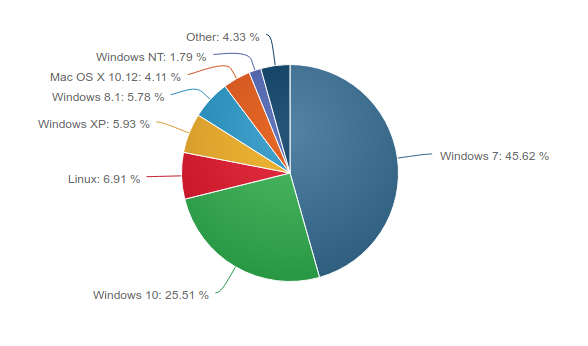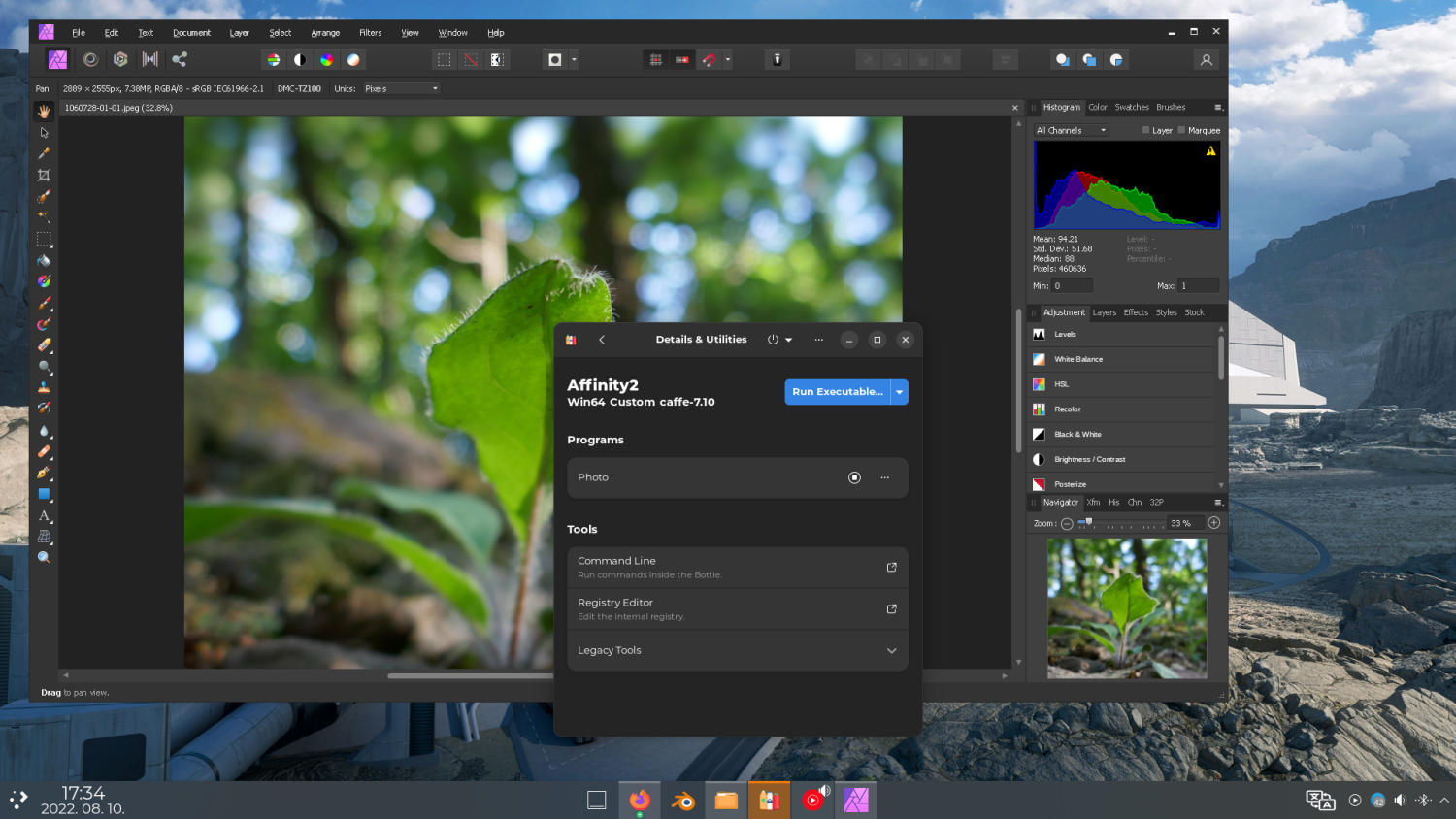Search the Community
Showing results for 'Linux'.
-
HEIF (HEIC) format support on export
Lewis Levin replied to forwanderer's topic in Feedback for Affinity Photo V1 on Desktop
Here is the answer via KAGI web search on whether there are incremental licensing costs for using Apple's HEIC code: Based on the available information, it appears that Apple does not require developers to pay additional license fees to use code libraries that support the HEIC image format: The Apple Developer Program has an annual fee of $99 USD, which provides access to various Apple developer tools and resources. [1][2] There is no mention of any additional fees specifically for using HEIC support libraries. [3][4] However, one source indicates that the HEVC video codec, which is related to the HEIC image format, requires a $0.99 extension to function. [5] So in summary, while Apple does not seem to charge extra fees for HEIC support libraries, there may be third-party costs associated with certain codecs used in HEIC files. But the core Apple Developer Program membership does not require any additional fees specifically for HEIC.[3][4] Membership Details - Apple Developer Program Choosing a Membership - Support - Apple Developer Apple Developer Program License Agreement - Support Agreements and Guidelines - Support - Apple Developer Why is HEIC not popular? : r/apple - Reddit In all likelihood, there is no per unit fee and only the Apple developer annual fee. Microsoft also supports HEIC and so they also probably have developers covered. Who knows (cares?) about this on Linux--sort of moot for Serif/Canva who don't support Linux for any of their products. -
Hi all, Currently making the transition to Linux (Zorin OS) and Affinity Photo is really the only thing that's keeping me from leaving Windows entirely. I tried VirtualBox and Bottles, but had difficulty getting Affinity Photo to run in both instances. Anyone have an easy solution? Thank you in advance for any help you can provide.
-
Since a few peoples were interested in a "guide" to get Affinity v2 working on Linux here it is, Before asking for help or sending logs here try and troubleshoot issues yourself with WineHQ's documentation : https://wiki.winehq.org/Wine_User's_Guide https://wiki.winehq.org/Building_Wine Before anything else I'd like to state that this does NOT deliver a stable nor 1:1 experience to what Windows10/11 will give you but i believe it to be an important step for Serif to witness Affinity's potential on the Linux ecosystem. And that yes peoples like us, going to this hacky extent to get your products working on our OS of choice is meaningful so please consider your marketing impact if a native version were to exist. An other note to Serif, Affinity's devs and managers :
-
Actually it is 2.76% after 30 years, not 13. I have seen stats saying nearly 4%, but that is for ALL of the 500+ different Linux distros. That is the problem Linux is always "going to be the next big thing" for 30 years. Other than on servers, it isn't, and won't be. This video makes interesting watching on the stats. NOTE it takes every major version of Windows as a separate OS but lumps ALL the Linux versions and distros as one lot. That is the problem Linux is badly fragmented and all distros and versions change asynchronously with no roadmap. Also, the multiple different licences also change asynchronously and can do so at any time. For Linux to be a serious host, much has to change in the way it is developed. See any of the multiple Conference videos of Linux explaining this for the last decade (or more). IT is highly unlikely to happen. As noted above it makes far more sense to support chrome rather than Linux(es) .
-
Fair enough, but we are arguing between insignificant and miniscule. Especially as that 4% is for well over 500 different distributions and versions. (most of which are obsolete and unsupported) If the video treated them in the same way it split the windows versions, Linux would not appear at all. This is the problem of fragmentation and distros liable to change at any time regardless of any supposed roadmap. Black magic did their Linux version based on ONE commercially supported Linux that they could customize. When that version went obsolete (as the vast majority of Linuxes do without warning) they swapped to ONE other commercially supported Linux rather than trying a Flatpak. So it is not 4% of the market but 0.1 + 0,001 + 0.02 + 0.003 + .... Etc any one of which could change (or go obsolete) at any time without warning. The other problem is that whereas Apple Inc. and Microsoft Inc have NDA's they also have licences with various codec producers. So until Linux Inc. can sign NDA's and buy licences it will always be missing some codecs. BMD did buy licences for codecs for their (dongled and paid for ) Linux version, but they had 60 users spending $1/4 million each for them. For Windows, there are compatibility modes that work for 99% of apps going back to Win 95. What is missing are some of the hardware drivers for some of the obsolete hardware.
-
If Linux will get a significant market share, maybe Some numbers: Marketshare of desktop Linux in Europe: January 2010 0.7% March 2024 2.76% I wouldnt call 2.76% a significant market share after being for over 13 years in the market ChromeOS is also close to this (2.44%), so why not also a version for ChromeOS? OSX is currently at 14.68% (last year over 20%!) And how many out of those are potential customers? Maybe you understand now, why Linux is not a market where you put huge investments in developing software, not talking about the typical LInux user being a fan of open source. I was selling for over 10 years Linux for servers (OK, not the software but services ) to huge enterprises and none of them ever considered seriously Linux as an desktop OS.
-
I can understand the economics behind not having a Linux version of Affinity. But ! Could things change ? I run a nice reliable PC. Z97 Mobo, i74790K CPU home build that falls just short of W11 compatibility. The ASUS Z97 even has TPM 2 ability. For my use a new PC is neither needed or wanted, my machine does everything that I need it to do, as fast as I need it. I have a backup machine almost identical, that is hardly ever used. So between the two, I am going to be good for a number of years, and have no intention of sending them to landfill just so that the Tech companies can make a financial killing. I have a number of spare front bays and have just installed Ubuntu on one of them. If I have to use Ubuntu while online after W10 security updates cease, then so be it. If I have to use Ubuntu exclusively, then so be it. In the intervening years, how many more people are going to take a similar course of action to myself ? This morning I have been looking at some software that claims to enable PC software, to run on Linux/Ubuntu. So. In the future, things at Affinity may change in relation to Linux. Lets hope ! As an afterthought, perhaps Affinity could include something in their script that helps to enable the use of third party software giving compatibility with Ubuntu/Linux ?
-
Linux is more popular on the desktop than macOS now - https://netmarketshare.com/ -> Desktop Trend (6.91%). NetMarketShare is a company which is sponsored by Microsoft, so I believe that their data is reliable enough. Taking statistics into account, what would be your response about Linux version of Affinity Photo and Designer?
-
I am writing to request an update on the potential release of a Linux port of the Affinity Suite. I understand that in the past, the small user base for Linux compared to macOS and Windows was a concern. However, I would like to bring to your attention that the number of Linux users has significantly increased since the forum posts discussing this issue in 2016-2018. This survey conducted by Stack Overflow, demonstrates the increased adoption of Linux by professionals developers. A similar survey show the same increase in VFX studios, and other artistic industries for stability and deployment reasons. Both shows that Linux exceed macOS's user base by a significant amount. I also wanted to mention the availability of Flatpak / Flathub as a solution to the issue of portability and stability across different Linux distributions. In addition, I wanted to address the concern of profitability in the development of a Linux release. While it is not a perfect solution, I have seen that the Affinity Suite primarily uses OpenGL, who have been implemented well on Linux and .NET 4.8 achieve acceptable stability through the use of wine. As a professional photo editor, vector graphics, and page layout software, the Affinity Suite would be a valuable addition to the Linux ecosystem, filling a gap in the market for high-quality professional software on this platform. I hope that you will consider these points in your current position on a Linux release. I respectfully request that Could you provide us with your current stance on a Linux release, taking into account the points mentioned above.
-
Also a lot of professional Resolve studios use Linux BUT that is only one (one current and one legacy) Linux. This is because Resolve was delivered on a Linux when Resolve was many $1000's per seat, and you needed at least $30,000 hardware as a dongle to use it. However, these users are a VERY small number compared to the whole number of Resolve users (over 2 million). Had it not been for the original resolve users buying it at well over $50,000 a seat, there would not have been a Linux version. It was a custom Linux and it came on the computer that came with Resolve. When it got to Resolve being sub $1000 that didn't need a dongle: They did a mac version then a windows version and some time later a Linux version that ran without needing $30,000 of hardware. The free Linux version of Resolve only runs on one version of Linux (to a specific build and version number) It is also missing some codecs and has other restrictions. I am not sure the VFX market is going to be large enough to support a Linux Affinity. Also, would you swap to the Linux Affinity says you should use? It would probalby help if they used the same Linux as BMD, as I suspect the VFX people who want a Linux affinity will also be working with Resolve users
-
This is a direct question to the devs and/or moderators here that can answer for them. Not a debate topic. What conditions would need to be met for Serif to make a linux version of the affinity suite? How much of a global market share would linux need? If Adobe suddenly decides to make a linux version? A kickstarter campaign to guarantee the funds needed, removing all risk? Would it take Serif themselves becoming financially comfortable enough to be able to experiment and expand? What needs to be done to get a Linux version?
-
That went offtrack heavily. Im a VFX artist so I will keep it on that sense. 100% of VFX studios run on linux 100% of VFX studios only run windows for Photoshop, 100 % of VFX studios would be extremely onboard to get rid of both PS and Windows. Every 3d app that exists in both Linux and Windows/Mac versions runs better in linux. It just makes sense to have a linux version.
-
Good Luck with that Ubuntu changes version more often than Windows and support ends for each version far faster than for windows. If Ubunto is still there at that time.... The other thing is many of the components in Ubuntu come from 3rd parties. Your problems aren't Windows Security patches but Linux security.
-

Linux user base keep growing !
Chills replied to Wanesty's topic in Feedback for the Affinity V2 Suite of Products
You are comparing Linux to Unix. Linux is NOT a Unix, Both are POSIX OS and there are many POSIX OS and RTOS that are, like Linux, not a UNIX. They are all to a far higher quality than Linux. Point one: Re MS your bigotry noted. (though MS are not entirely "clean") Point 2 This is incorrect. State Actors have, and still do, introduce malware in to the Linux Kernel. Also distributions of Linux. The Thompson [Unix] Backdoor Hack was only on the initial unstable development kernel. It was removed when the kernel became stable. However when talking about it many years later the hack he described that, had he been malicious, he would have used is far more subtle and to this day is easy to implement to infect any Linux Kernel and GCC compiler. This alone makes Linux inherently unsafe. Point 3 you mention servers... There are headless versions of Windows and Unix, all which do work very well. They are also more secure than Linux unless you have skilled people who can lake Linux Secure. (Have you ever run static and dynamic code analysers over a Linux Kernel?) For embedded use Linux is not a good choice despite many using it. There are also embedded versions of Windows, some of which are headless. Pint 4 "Free" That tends to appeal to hobby people and corporate accountants. However the lifetime costs and risks usually outweigh this. -
This is so true. When you look at the very small number of desktop Linux users compared to the global number of desktop computer users and then the demographics in that userbase you can see why games are on Linux but not Affinity. Resolve was a very special case. There was a very custom Linux version of that when it was over $250K a seat and required over $25k of hardware as a dongle to make it work. When they brought out a $1000 Resolve, it was on Mac and then PC. The Linux version that didn't require expensive HW dongles was much later and on one, and only one, distribution of Linux. Even now, the Linux version of Resolve is missing stuff that is standard on Mac and PC. This won't change until Linux PLC signs agreements with various companies, and it is all delivered as a binary (not source code). If resolve are not doing expensive agreements to put these things into the Linux Resolve, there is no way Serif could justify it. The problem is you have Linux Religion vs real world business. No matter how noisy the Linux devotees are it doesn't add up for the real world accountants.
-

Linux user base keep growing !
MattyWS replied to Wanesty's topic in Feedback for the Affinity V2 Suite of Products
I see this thread turned into a windows vs linux fanboy style flame war and I'd like to just step in and say people should take a breath. If you use Windows and you love it and would never switch to anything else, good for you! You have the Affinity Suite on your OS of choice. This kind of topic is not about you and you gain nothing from trying to gatekeep what Serif does. You already got what you wanted from the start. This thread is about the people that daily drive a different OS that is severely lacking in the photo/vector editing side of things. I'm one of those people and I've made do with what I have (I use substance designer, krita and darktable for my image needs). It would be absolutely fantastic to have a good image manipulation software like affinity but even more so, I'm really missing affinity designer. I honestly think affinity would dominate the space if they made linux versions of their suite. It would be the best. There is practically no competition. As for people who are saying no one uses linux so Serif shouldn't bother, that hasn't stopped Autodesk from having Maya or Houdini, it didn't stop Epic's Unreal engine or Unity engine having native linux versions. It didn't stop FOSS projects like Blender, Godot, Gimp and Inkscape either. There's all kinds of professional software that has linux native versions that are maintained to this day alongside windows and mac versions, from massive corperations to non profits. I don't think anyone can say "no one uses linux" because obviously, we do. The desktop marketshare is rising to 5% if it's not already there, and for gaming it has overtaken Mac. There are whole companies banking on Linux like Valve, System76 etc. It's not dead and it's not dying, the linux marketshare is ever growing and IMO shouldn't be ignored. My reasons for using linux is because it's faster, sleek and completely under my control. I don't agree to the windows ToS. Anyone that uses windows has no control over their system, heck you don't even own windows, you are licensed to it which MS can revoke at any time they want. I'm a professional game developer (3d artists specifically) and I, along with many others, are fast realising this is an option we can take. This thread isn't about what is better out of linux mac or windows. mac and windows users already got what they want from Serif. Please stop bothering to gatekeep and let people discuss the topic at hand, which is that linux users want and need a suite like affinity and would welcome Serif! -
Hello all, Thanks to this thread I've been able to get 2.x running on Linux Mint, but the flickering is driving me insane. Unfortunately when I attempt to run 1.x I get the following error: Has anyone figured this one? Do I need a new wine environment? Unhandled Exception: System.AccessViolationException: Attempted to read or write protected memory. This is often an indication that other memory is corrupt. at Raster.Hardware<Raster::DefaultImplementation>.GetHardwarePossible() at Serif.Interop.Persona.Settings.PerformanceSettings.get_CanUseHardwareAcceleration() at Serif.Interop.Persona.Settings.PerformanceSettings.get_UseHardwareAcceleration() at Serif.Interop.Persona.Services.InteropService.Initialise() at Serif.Interop.Persona.Application.OnServicesInitialised(IServiceProvider serviceProvider) at Serif.Affinity.Application.OnServicesInitialised(IServiceProvider serviceProvider) at Serif.Interop.Persona.Application.OnStartup(StartupEventArgs e) at System.Windows.Application.<.ctor>b__1_0(Object unused) at System.Windows.Threading.ExceptionWrapper.InternalRealCall(Delegate callback, Object args, Int32 n umArgs) at System.Windows.Threading.ExceptionWrapper.TryCatchWhen(Object source, Delegate callback, Object ar gs, Int32 numArgs, Delegate catchHandler) at System.Windows.Threading.DispatcherOperation.InvokeImpl() at MS.Internal.CulturePreservingExecutionContext.CallbackWrapper(Object obj) at System.Threading.ExecutionContext.RunInternal(ExecutionContext executionContext, ContextCallback c allback, Object state, Boolean preserveSyncCtx) at System.Threading.ExecutionContext.Run(ExecutionContext executionContext, ContextCallback callback, Object state, Boolean preserveSyncCtx) at System.Threading.ExecutionContext.Run(ExecutionContext executionContext, ContextCallback callback, Object state) at MS.Internal.CulturePreservingExecutionContext.Run(CulturePreservingExecutionContext executionConte xt, ContextCallback callback, Object state) at System.Windows.Threading.DispatcherOperation.Invoke() at System.Windows.Threading.Dispatcher.ProcessQueue() at System.Windows.Threading.Dispatcher.WndProcHook(IntPtr hwnd, Int32 msg, IntPtr wParam, IntPtr lPar am, Boolean& handled) at MS.Win32.HwndWrapper.WndProc(IntPtr hwnd, Int32 msg, IntPtr wParam, IntPtr lParam, Boolean& handle d) at MS.Win32.HwndSubclass.DispatcherCallbackOperation(Object o) at System.Windows.Threading.ExceptionWrapper.InternalRealCall(Delegate callback, Object args, Int32 n umArgs) at System.Windows.Threading.ExceptionWrapper.TryCatchWhen(Object source, Delegate callback, Object ar gs, Int32 numArgs, Delegate catchHandler) at System.Windows.Threading.Dispatcher.LegacyInvokeImpl(DispatcherPriority priority, TimeSpan timeout , Delegate method, Object args, Int32 numArgs) at MS.Win32.HwndSubclass.SubclassWndProc(IntPtr hwnd, Int32 msg, IntPtr wParam, IntPtr lParam) at MS.Win32.UnsafeNativeMethods.DispatchMessage(MSG& msg) at System.Windows.Threading.Dispatcher.PushFrameImpl(DispatcherFrame frame) at System.Windows.Application.RunDispatcher(Object ignore) at System.Windows.Application.RunInternal(Window window) at Photo.Application.Main(String[] args)
-
There is no Windows religion. It is just a work horse that is there, and the vast majority of desktop business and home users use it. (over 80%?) It is a tool that is comparable with "everyone else". For most they don't care. There are faults with it, as there are with everything like this. But it just works on almost any hardware you throw at it and "everyone" does drivers and apps for it. IT is what it is. Macs do have more of a Fan-boy element became of the style and Apple cultivating it. Besides, people need to justify spending a lot more on a mac than a comparable PC. MACs were more reliable because Apple controls the whole infrastructure. That said, the shine has come off Apple of late due to changes in the way it works. Also this wasn't helped by Adobe having a change of business model at a similar time. So many were reassessing their position. Linux on the other hand has a very small part of the desktop market, usually only in certain sectors and its users shout many , many times louder than 90% of the Windows users. (most of whom couldn't give a monkey's) The Linux users start shouting their user base has doubled... From infinitesimal to insignificant and wonder why companies are not rushing to support linuxes Linus Torvld has explained many times why Linux is not going to work as a mainstream desktop.... there are penalty of videos of him explaining it at conferences over the last decade. The other more significant reason: that he has talked about and got savaged by Linux people, is how the kernel is patched. This coupled with how distributions are done make it a non-starter for most apps. I have worked in computing for over 35 years, mainly on critical systems, and seen the problem people have with Linux. I Work with a company that supplies dev tools. If you are working with Linux as a target the at a 10% surcharge as a line item because Linux is such a mess to support. That is the commercial reality. This is why the Linux is a region. Its devotees don't seem to understand economics or business. There is a business case for Linux but it is not as a desktop OS.
-

Affinity products for Linux
Helmuth Pandora replied to a topic in Feedback for the V1 Affinity Suite of Products
So I’m hoping the Canva acquisition has a positive side, that affinity is ported to Linux, so Educational Institutions can you use ist for free, also when there infrastructure and endures devices are on Linux. Affinity getting to Linux and Inkstitch ever improving would enable me to finally ditch windows. -
Hi, There's *finally* a way to run Affinity Photo and Designer on Linux and it's pretty easy actually. Steps: 1. Install Bottles (from https://usebottles.com/ or your appstore) 2. From Settings/Runners, install 'Caffe 7.10' 3. Download the custom recipe file (from Kontik from the Bottles Telegram chat) 4. Create a new bottle, click 'Custom' and choose the recipe (AffinityCustomBottleRecipe.yml) 5. Click the 'Run executable' button and choose your downloaded .exe (Download from your Affinity Account) 6. Install it like the Windows version 7. Click the three dots next in the 'Photo' card of the 'Programs' list choose 'Change Launch options' and add the following to 'Command arguments': --no-hw-ui argument There are still glitches and crashes but it's still someting P.S.: Let me know if you'd like a video tutorial AffinityCustomBottleRecipe.yml
- 176 replies
-
- linux
- linux photo
-
(and 2 more)
Tagged with:
-
I think this is incorrect. Mac and Windows have about 87-88% global desktop share. with linux rising to around 4-5% not including chromeOS which is also just linux (it is, get over it), which is around 2-3% and the rest is unknown (though I don't know if steamdeck is counted, it's technically a linux desktop but I doubt most people use the browser so they may not get counted). If we're being conservative here linux is 6-7% desktop share really, give or take a few million steamdeck users if they were counted. I'm curious about the remaining ~6% unknown desktop share though. They're desktops, but those who care enough to mask themselves are probably the paranoid linux crowd lol... Which would make the linux share more like 12% but we'll never know that for sure. The stats I think are based on desktop browser use. RIP FreeBSD, clearly dead in the water.
-

Linux user base keep growing !
MattyWS replied to Wanesty's topic in Feedback for the Affinity V2 Suite of Products
This is probably because linux users actually want to use linux, while most windows users are stuck with what they got from the store. I've noticed the loudest anti-cross platform people in this forum often say they totally daily drive Linux, but if that were true they wouldn't be so against their favourite softwares coming to Linux. Best guess is they just use windows and want to get a leg up in the debate like "guys come on I totally use Linux daily and it's awful no one should use it, I should know because I totally use it myself, please don't make software for me or Linux even though i totally use it." - Seems sus. Cross platform software should be encouraged and celebrated. -
It's important to note, my primary motivation to post on this topic is to help other people who are looking for ways to use Linux as their main daily driver and are having difficultly building a complete pipeline for image creation. I'm not trying to convert people who are happy using other systems. I don't see it as a religion, just an option, and we are lucky to have these kinds of options at zero cost of entry. The only cost is the time to learn something different to Windows or MacOs. I am also not offering any advice or insight into Linux vulnerabilities, especially for critical systems. I'm not sure how that is relevant for people who want to edit photos with Affinity Photo on a desktop PC, I would assume any OS not designed for critical systems would be quite vulnerable to targeted attack. Your primary motivation doesn't come across like it's driven by any a concern for peoples data security or to be helpful in general, you seem to be putting most of your energy into shouting down anyone who wants to use Linux as a desktop environment using your experience in critical systems as the main crux for that argument. The fact remains, if Linux is such a non-viable option as a desktop environment. Why has it persisted for all these years? and people are actually using it as a desktop environment and developing compatible multi platform software. It would be safe to say uptake of Linux has increased in recent years, you'd expect something that has little chance of being a major desktop environment would see dwindling numbers, not increasing numbers. My primary industry is CGI and VFX. I use Blender for many things and it is safe to say it is a popular Linux application. If you look at the benchmark data for their pathtracer, you can see benchmark results categorized by OS. Here you can see Linux actually has more submissions than Mac OS. Whilst this is not definitive and is possible some are render nodes, it does appear that more than 4% of Blender users are Linux based. Blender also works on all Linux Distros using a single deployment. The Blender Foundation also produce films with it using their in house team who all use Linux. https://opendata.blender.org/ You also have to look at the gaming scene. Linux has seen a huge uptake since Valve included proton compatibility layer implementation into Steam, bare in mind, Gabe Newell (owner of Valve) is ex Microsoft staff (13 years & oversaw the first 3 releases of windows). They also use Ubuntu as a base for the Steamdeck portable gaming device. Unreal Engine, directly supports Linux and is using a multi distro deployment. It is totally viable to develop realtime 3D content and video games using Linux with nothing but UE5. You also have Autodesk Maya, Nuke, Flame and even Adobe Substance Painter/Designer. Some major film post production studios use RHEL Linux to do VFX for feature film. When you couple all of this with excellent Windows emulation of many games and software via Wine/Lutris. I would say it is indeed an incredibly viable option for creative professionals. I haven't booted into Windows for over 18 months. Linux even reserves less of your vRam for the OS which directly improves rendering performance. If you are correct with what you say about Linux not being ready, then you are presenting at the very least a highly subjective opinion and at worst a polarizing slightly out of touch opinion, if you look at who is using it in creative industries as an example. I think the take home point here, is, can Linux be a viable desktop environment? yes absolutely (I am), but it is relative. You can make an argument from which ever lens you choose to view it from. And no one opinion is better than another. It's just what works for you and what does not. I'm not saying everyone can use Linux as a desktop environment but you appear to be suggesting that no one should bother trying based on your perspective. Which IMO is not constructive.
-
Yea notice how no one is calling it a Windows religion or Mac religion, despite how this topic is to specifically discuss linux and there are windows crusaders in here going "NooOoOoOOoOOoo" for zero gain other than to try to thwart linux users and dissuade Serif? If using a different OS to you counts as a religion in your head while you are going out of your way to do this, you need therapy, because I doubt linux users are going into every other request topic and saying "NO serif shouldn't add this feature they need to spend their money on me and my OS instead" like you're doing here. It's strange, the mental gymnastics I've seen you and others do on these forums trying to gatekeep how Serif spends their time and resources. Heck this topic is specifically asking the best ways to run the software on linux regardless of official support and thanks to people like yourself it's devolved into a thread about why you don't like linux.










